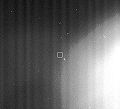- Methone (moon)
-
Methone  Methone as seen by Cassini taken in September, 2010Discovery
Methone as seen by Cassini taken in September, 2010DiscoveryDiscovered by Cassini Imaging Science Team Discovery date June 1, 2004 Epoch June 20, 2004 (JD 2453177.5) Semi-major axis 194,440 ± 20 km Eccentricity 0.0001 Orbital period 1.009573975 d[2] Inclination 0.007 ± 0.003° (to Saturn's equator) Satellite of Saturn Physical characteristicsMean radius 1.6 ± 0.6 km[3] Rotation period synchronous Axial tilt zero Methone (
 /mɨˈθoʊniː/ mi-thoh-nee; Greek: Μεθωνη) is a very small natural satellite of Saturn lying between the orbits of Mimas and Enceladus.
/mɨˈθoʊniː/ mi-thoh-nee; Greek: Μεθωνη) is a very small natural satellite of Saturn lying between the orbits of Mimas and Enceladus.It was first seen by the Cassini Imaging Team[4][5][6] and given the temporary designation S/2004 S 1. Methone is also named Saturn XXXII.
Methone is visibly affected by a perturbing mean longitude resonance with the much larger Mimas. This causes its osculating orbital elements to vary with an amplitude of about 20 km in semi-major axis, and 5° in longitude on a timescale of about 450 days. Eccentricity also varies on different timescales between 0.0011 and 0.0037, and inclination between about 0.003° and 0.020°.[1]
The name Methone was approved by the IAU Working Group on Planetary System Nomenclature on January 21, 2005.[7] It was ratified at the IAU General Assembly in 2006. Methone was one of the Alkyonides, the seven beautiful daughters of the Giant Alkyoneus.[8]
-
Discovery image of Methone on June 1, 2004[9]
References
- ^ a b Spitale, J. N.; et al. (2006). "The orbits of Saturn's small satellites derived from combined historic and Cassini imaging observations". The Astronomical Journal 132 (2): 692–710. Bibcode 2006AJ....132..692S. doi:10.1086/505206. http://www.iop.org/EJ/article/1538-3881/132/2/692/205235.html.
- ^ NASA Celestia
- ^ Thomas, P. C. (2010). "Sizes, shapes, and derived properties of the saturnian satellites after the Cassini nominal mission". Icarus 208: 395–401. Bibcode 2010Icar..208..395T. doi:10.1016/j.icarus.2010.01.025. http://www.ciclops.org/media/sp/2011/6794_16344_0.pdf.
- ^ Ciclops.org
- ^ C.C. Porco, et al., IAUC 8389: S/2004 S 1 and S/2004 S 2 August 16, 2004 (discovery)
- ^ Porco, C. C.; et al.; (2005); Cassini Imaging Science: Initial Results on Saturn's Rings and Small Satellites, Science, Vol. 307, No. 5713, pp. 1226-1236
- ^ IAUC 8471: Satellites of Saturn January 21, 2005 (naming the moon)
- ^ Early press releases of the discovery mentioned the first person to see the moon in Cassini images. This bit of trivia was blown out of proportion in the following months, with this individual being credited as the "discoverer" by some sources. Because the discovery was a large team effort, involving tens of people and hundreds of hours of distributed work, a conscious decision was made by the IAU to officially and correctly assign any credit to "the Cassini Imaging team" and to avoid unfairly singling out any one individual as the discoverer.
- ^ Photojournal.jpl.nasa.gov
External links
Listen to this article (info/dl)
This audio file was created from a revision of Methone (moon) dated 2010-01-16, and does not reflect subsequent edits to the article. (Audio help)More spoken articles- Methone Profile by NASA's Solar System Exploration
- IAU Working Group for Planetary System Nomenclature
Moons of Saturn Generally listed in increasing distance from Saturn. Temporary names in italics. Ring shepherds - S/2009 S 1
- Propeller moonlets
- Pan
- Daphnis
- Atlas
- Prometheus
- ?(S/2004 S 6
- S/2004 S 4
- S/2004 S 3)
- Pandora
Co-orbitals G Ring - Aegaeon
Inner large
(with Trojans)Alkyonides Outer large Inuit group Norse group Gallic group Categories: -
Wikimedia Foundation. 2010.

